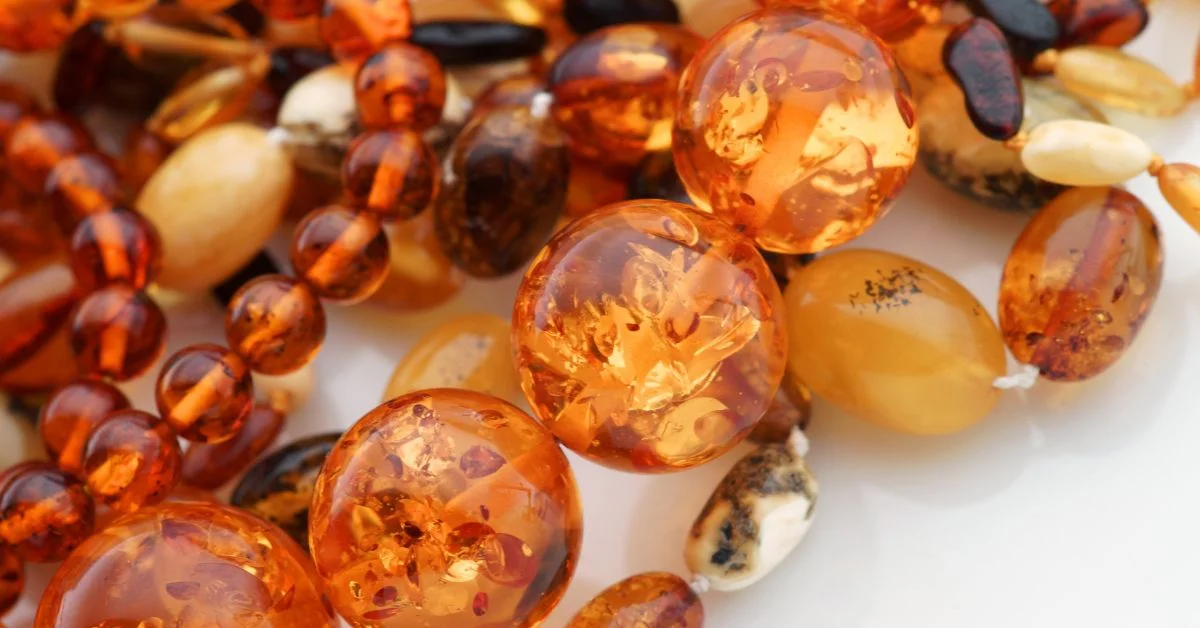Throughout history, jewelry has never been just about decoration. It has been an expression of culture, protection, and personal energy. Among the countless adornments worn by humans across civilizations, amber necklaces hold a particularly fascinating position. Unlike gemstones that are formed deep within the earth under pressure, amber is fossilized tree resin that carries millions of years of history within its golden glow. Wearing an amber necklace is not only about aesthetics—it is also believed to carry symbolic, therapeutic, and cultural value.
People wear amber necklaces for different reasons: some for beauty, others for spiritual healing, and many for its supposed soothing properties. Parents have even used them on infants in the belief that amber helps relieve teething discomfort. Whether as a statement of fashion, a cultural relic, or an alternative remedy, the amber necklace is more than just a piece of jewelry; it is a timeless link between nature, history, and human tradition.
In this detailed article, we will explore the origin of amber, the history of amber necklaces, their symbolic and therapeutic uses, scientific debates, cultural importance, types of amber, modern fashion perspectives, and how to care for amber necklaces. Along the way, we will examine myths versus facts and provide structured comparisons that allow you to understand both the mystical and practical sides of amber.
What is Amber?
Amber is not technically a gemstone; it is fossilized resin from ancient trees, primarily coniferous species, that lived millions of years ago. Over time, this resin hardened, preserving small fragments of history such as plant matter, insects, or bubbles. Because of this, amber pieces are often unique, carrying tiny records of prehistoric life within them.
- Formation
Amber forms when resin exuded from tree bark hardens and undergoes molecular changes over millions of years. This process, called polymerization, creates the hardened, lightweight substance we now wear as beads or pendants. - Color
Amber occurs in a variety of colors. The most common are golden yellow and honey tones, but amber can also be found in shades of brown, orange, green, and even rare blue hues. - Properties
- Lightweight and warm to the touch
- Often contains inclusions (tiny trapped organisms or materials)
- Can be polished into beads, pendants, or ornaments
Historical Significance of Amber Necklaces
Amber necklaces are not a modern trend; they trace back thousands of years.
- Prehistoric Use
Archaeological finds suggest that humans wore amber ornaments as early as the Stone Age. People valued amber for its bright glow and mystical appearance, believing it had protective powers. - Ancient Civilizations
- Egyptians: Amber beads were buried with pharaohs as symbols of eternal life.
- Greeks and Romans: Amber, called electrum by the Greeks, was thought to hold sunlight and was used in amulets.
- Baltic Regions: Amber trade routes were highly significant in Europe, known as the “Amber Road.”
- Middle Ages
During medieval times, amber necklaces were worn for protection against evil spirits, disease, and bad fortune. Monks and healers often used amber in religious relics and healing rituals. - Modern History
In the 19th and 20th centuries, amber jewelry became a fashionable accessory in Europe and America, valued not only for its historical symbolism but also for its natural beauty.
Symbolism and Meaning of Amber Necklaces
Amber necklaces hold a wide range of meanings across cultures and beliefs:
- Sun Symbolism: Amber’s warm golden hue has long been associated with the sun, life, and vitality.
- Protection: Many believed that amber warded off evil spirits and negative energy.
- Healing Energy: It was considered a natural purifier capable of drawing out sickness and pain.
- Connection to Nature: Because amber comes from ancient trees, it symbolizes harmony between humans and nature.
Types of Amber
Amber can be classified by origin, color, and quality.
| Type of Amber | Characteristics | Main Sources |
|---|---|---|
| Baltic Amber | Rich golden color, most common in jewelry | Lithuania, Latvia, Poland |
| Dominican Amber | Known for rare blue tones and clarity | Dominican Republic |
| Burmese Amber | Deep reddish-brown hues | Myanmar |
| Mexican Amber | Transparent with strong golden-orange shades | Mexico (Chiapas) |
| Sicilian Amber | Older, unique fossil inclusions | Italy |
Uses and Benefits of Amber Necklaces
Amber necklaces are admired for their beauty but are also worn for their alleged therapeutic properties.
1. Fashion and Beauty
Amber necklaces provide a warm, natural glow that complements different skin tones. They are versatile, matching both modern and traditional outfits.
2. Healing Beliefs
Supporters of natural healing claim amber contains succinic acid, which, when warmed against the skin, releases soothing properties that:
- Reduce inflammation
- Ease teething pain in babies
- Calm stress and anxiety
- Boost the immune system
While scientific research does not strongly confirm these claims, many wearers swear by the benefits.
3. Spiritual Uses
Amber is considered a stone of energy cleansing. Spiritual practitioners use it during meditation to promote clarity, positivity, and grounding.
4. Cultural and Traditional Use
In Baltic and Eastern European cultures, gifting amber necklaces is a tradition, symbolizing health and protection.
Amber Necklace for Babies: Myth or Reality?
One of the most controversial uses of amber necklaces is for infants. Many parents buy them to ease teething discomfort.
Belief: Succinic acid in amber beads is absorbed through the skin, reducing pain and drooling.
Reality: Scientific evidence supporting this is limited, and medical experts often warn about choking hazards. While some parents share positive experiences, safety precautions such as close supervision and using well-made necklaces are crucial.
Comparing Amber Necklace with Other Healing Jewelry
| Jewelry Type | Material | Believed Benefits | Popular Use |
|---|---|---|---|
| Amber Necklace | Fossilized resin | Pain relief, calming, energy cleansing | Adults & infants (teething) |
| Crystal Necklace | Quartz, amethyst, etc. | Energy balance, chakra healing | Spiritual practices |
| Magnetic Necklace | Magnetic metals | Improved circulation, reduced pain | Arthritis & joint issues |
| Pearl Necklace | Organic (oysters) | Purity, emotional balance | Fashion & cultural ceremonies |
Fashion Perspective on Amber Necklaces
Amber necklaces have made a comeback in modern fashion, not only as healing jewelry but as eco-friendly, sustainable accessories. Designers now incorporate amber into minimalist styles, chunky statement pieces, and vintage-inspired collections. Unlike synthetic gemstones, amber’s natural inclusions and unique glow make every necklace one of a kind.
Celebrities and influencers have also embraced amber necklaces, further popularizing them among younger audiences who value authenticity and earthy aesthetics.
Caring for an Amber Necklace
Amber is softer than gemstones, so proper care is important:
- Cleaning: Wipe with a soft cloth. Avoid chemical cleaners.
- Storage: Keep away from sharp jewelry that may scratch it.
- Avoid Heat: Prolonged sun exposure or heat can darken amber.
- Polishing: Use olive oil or a mild polishing cloth to maintain shine.
Misconceptions about Amber Necklaces
- Amber is a Gemstone – False. It is fossilized resin, not a mineral.
- Amber Necklaces Cure Diseases – No scientific proof; they may provide comfort but not medical cures.
- All Amber is the Same – Quality varies widely depending on source and inclusions.
- Amber Lasts Forever – It is relatively soft and can scratch or darken over time.
Table: Pros and Cons of Amber Necklaces
| Pros | Cons |
|---|---|
| Natural, eco-friendly material | Softer, prone to scratches |
| Believed healing properties | Scientific evidence is limited |
| Lightweight and comfortable | Can darken over time |
| Unique with natural inclusions | Higher risk of counterfeit amber |
| Timeless historical value | Baby use raises safety concerns |
Conclusion
Amber necklaces are more than just jewelry—they are a bridge between history, nature, and human culture. For thousands of years, people have admired amber not only for its beauty but also for its symbolic and healing qualities. From ancient Egyptian amulets to modern fashion runways, amber necklaces have retained their charm and significance.
While the therapeutic claims surrounding amber remain debated in science, the cultural, emotional, and spiritual connection people feel toward these necklaces cannot be ignored. Whether you wear one as a fashion accessory, a spiritual tool, or even as an heirloom, an amber necklace is a piece of history glowing warmly around your neck.
FAQs
1. What is an amber necklace made of?
An amber necklace is made from fossilized tree resin, often shaped into beads or pendants and strung together.
2. Are amber necklaces safe for babies?
While many parents use them for teething, doctors warn about choking risks. Supervision and safety precautions are essential.
3. Do amber necklaces really have healing benefits?
Amber is believed to release succinic acid, offering soothing effects, though scientific evidence is limited.
4. How can I tell if an amber necklace is real?
Real amber is warm to touch, lightweight, and may contain natural inclusions. Fake amber is usually plastic or glass.
5. How do I clean and maintain an amber necklace?
Use a soft cloth to gently wipe it. Avoid harsh chemicals, prolonged sun, and store it separately to prevent scratches.
For more information, click here.









